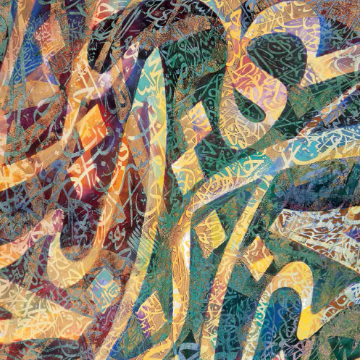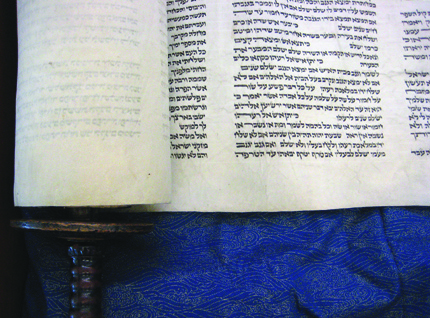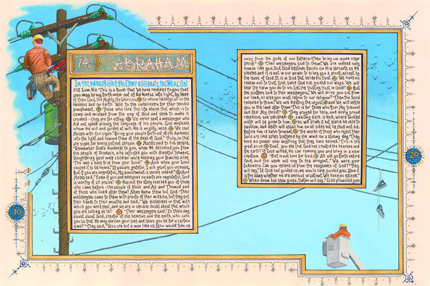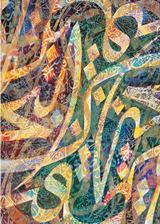
Sacred Text, Sacred Space
How Closed Texts Open to Infinity
There are few things that academics like better than texts, particularly those of us who work in the humanities. We produce them and prescribe them for our students; we collect and translate, analyze and gloss them.
Since the rise of post-modernism, we seem to have been in a constant pother about the nature of “the text,” yet somehow that has not prevented us from carrying on our typically modern affair with texts. Who could imagine a university—Jesuit, Catholic, or whatever—without them? Even if we are in the sciences, whether “hard” or “soft,” we digest our findings into what we hope will be published texts. And though we may have advanced from warehousing those texts on shelves to storing them on servers where they can be almost limitlessly available, they still seem so comfortingly objective because they are there for anyone to consult and verify.
Given this predilection for texts in university education, sacred texts run the risk of just being subsumed under that broad category and of losing their particularity. Texts become sacred, not because of any inherent literary property, but because communities of faith have come to consider them so. They have canonized them. That is to say, they have recognized that a certain particular text or group of texts somehow express truth and so make a particular claim on them. We could say that it is the sacredness of the human person that demands we take these texts seriously in the academy. It is respect for the believers that is the basis for our respectful approach to the text. Recognizing the importance of these texts for the communities for whom they are sacred is the reason we take them seriously, not only in theology or religious studies, but in political science and history, in psychology and sociology.
The claim that people sense the text making on them may not be a normative claim, even when the texts in question are legal texts—think of the relationship of the Christian community or, perhaps even more surprisingly, that of the rabbis to the letter of the written Law (Torah).(1) Think, too, of the attitude of Hindu sages to the animal sacrifices of the Vedas. However, the claim the sacred texts make is at the very least what we might call formative. That is, these texts are an essential element in the complex process of forming the identity of the faith community.(2)
We could say that the community’s identity is formed in the space the text creates—in this sense, the text is a locus for the community rather more than a blueprint; the world of the text is the space of divine communication rather than the sum total of it. Sacred texts are not merely (sometimes not at all) informative; they are performative. They enact the relationship within which the believing community hears the divine word. Take the reading of the first creation account in the book of Genesis at the beginning of the Easter Vigil: it serves not to provide information about the origins of our planet and its various species, but rather to establish in that moment a space in which the creative word and work of God and the human relatedness as God’s “image and likeness” are recognized and made real.

Recognizing this distinction between normative and formative modes of canonicity is essential, particularly when approaching sacred texts not our own. A contemporary example might illuminate this: anti-Muslim polemicists are fond of pointing to various Qur’anic injunctions—for example, the verse about the possibility of beating a recalcitrant wife (Q 4:34) or the command to amputate the hands of thieves (Q 5:38)—in order to discredit the scripture and hence the religion as a whole. The text seems to promise a reliably independent source of insight into the faith of the community that acknowledges its authority. Whatever they might say of themselves, since their foundational texts are available, believers’ claims can be checked against them for accuracy. Polemicists brandish these verses and insist they must be normative, using them to discredit other voices, who are judged to be hiding the true horror of their religion.
Indeed, the most complex thing about scriptures is the way in which these clearly delimited texts relate to limitless truth; how these culturally specific and often historically particular texts relate to a truth beyond mere culture and history.
Yet those very same people can happily carry a Bible that still insists on the extermination of the Amalekites, even down to the babies at the breast, in revenge for an attack on Israel generations before (Dt 25:17–19; 1 Sam 15),(3) and that commands the death penalty for a rebellious son (Dt 21:18–21) or advises gouging out one’s own sinful eye (Mt 5:29; 18:9). They know, even if only instinctively, the difference between formative and normative canonicity, yet they do not easily extend that distinction to other scriptures and their communities of faith.
The origins of sacred texts may be irretrievably obscured by the mists of time, like the Vedic mantras; or they may be precisely attributable to a more or less historically locatable author, like some of the New Testament letters. The texts may be aware of themselves as scripture, as the Qur’an seems to be; or they may be as unself-conscious as the Song of Songs. They may be canons composed of varied texts spanning centuries, like the Bible; or they may be unitary works with a relatively brief composition history, like the Book of Mormon. They may disclose their authors, like the Adi Granth; or veil them, like the Gita. What these texts have in common is that, in the eyes of their communities, they are expressions of the Truth. Indeed, the most complex thing about scriptures is the way in which these clearly delimited texts relate to limitless truth; how these culturally specific and often historically particular texts relate to a truth beyond mere culture and history. Jonathan Z. Smith has observed that canonization is a double process: the closure of the text, and then the use of exegetical ingenuity “to extend the domain of the closed canon over everything that exists without altering the canon in the process.”(4) Outsiders to a religious tradition often only see the closed nature of the canon and, if they know of it at all, they sometimes see the exegetical ingenuity of rabbis, ulema, and theologians as somehow secondary to the canon rather than as an essential element of canonicity. One cannot understand sacred texts if one sees only the closing without the opening, only the limitation without the extension.
Modernity has not been kind to canonicity, since it has tended to regard the exegetical ingenuity that extends the text as so much medieval obfuscation and priestcraft—not for nothing have “jesuitical” and “talmudic” sometimes been thought to be synonymous terms of opprobrium! The privileging of the relation of the literate individual to the original text—something we pride ourselves on in academia—has often led to the jettisoning of centuries of wisdom acquired in the process of negotiating the relationship between the text and the world that the community inhabits.
These texts are taken to be expressions of truth, but what happens when they seem to conflict with what the believer holds or even knows to be true? She cannot simply disregard the sacred text; she must find a way of reading it that will resolve the conflict or bridge the gap. She has two choices: she can privilege what she knows to be the case and then find a way of reading the text that is consonant with that. Or, alternatively, she can adopt the position that what she thinks she knows must bow before the plain meaning of the text. Maimonides considered this question at length with regard to the relationship of Torah to philosophy, though not to the satisfaction of all. Being convinced of the metaphysical truth that God is not a material body, he chose to read as figurative any biblical passages that spoke of God’s hands, wings, or face. The same position had been taken earlier by the Mu’tazilite readers of the Qur’an’s anthropomorphisms. If he were convinced of the eternity of the world, Maimonides tells us, he would be prepared to read as figurative even the many passages in the Torah that speak of its being created in time.(5) The principle is to give the most charitable reading of the text that will allow it to stand alongside other reliably based convictions.

There is a whole array of methods available to the believer to help negotiate this relating of the text to what we know to be true: etymology and semantics, grammar, textual variants, abrogation and contextualization, to name just a few. Furthermore, every part of a canon must “negotiate” with other parts. By being included in the canon, a text or part of a text seems to become more sacred and hence more authoritative. However, at the same time, it must accept to be read alongside alternative voices in the same canon. Many Muslims will consider the Qur’an verse that states, “There is no compulsion in religion” (Q 2:256), more authoritative than various verses that enjoin fighting against those who do not believe (e.g., Q 9:73, 123), or than the similarly canonical sayings of the Prophet to similar effect. Halbertal offers the example from the Hebrew Bible of the rather hard-bitten and even heretical Qoheleth (Ecclesiastes), which many of the rabbis would rather have seen buried than canonized. The sting of this tract’s cynicism is softened or even lost once it is included in scripture, since the reader will now find ways to understand it as consonant with the rest of the canon.(6) Yes, as scripture it speaks with a more authoritative voice; but it is no longer allowed to say what it wants. In that respect, canonization can seem rather like ordination!
This approach to finding what we might call the most charitable reading of a text recalls the Presupposition of Ignatius Loyola’s Spiritual Exercises (22) in which he maintains—no doubt schooled by bitter experience—that one ought to be more ready to justify than to condemn another’s statement, and that one should spare no effort in finding a positive understanding of it in accord with the truth. This is surely good advice in any situation, particularly when dealing with canonical texts, yet it may have its limits. Though some, like the polemicists already mentioned, seek the most uncharitable reading of the text in order to desacralize it, other believers will argue that the text does not need our charity. The text is sovereign, and it is rather the reader’s notion of truth that must bow. This attitude we know from the experience of scriptural literalism, in both its bloody and merely bloody-minded forms: whatever the rights and freedoms of the other, scripture says they deserve to die; whatever the fossil record might say, whatever the evidence of our telescopes, they must bow before the literal meaning of the scripture.
Even if one affirms such sovereignty of the text, however, one is not condemned to a shallow reading. Traditions have long maintained that sacred texts are multilayered, or three-dimensional. They have depths hidden below the surface, and so their content is not simply coextensive with the text as it appears to the casual reader. The Islamic tradition speaks of the zahir (outer) and the batin (inner), and one finds in many religious traditions notions of the exoteric and esoteric meanings of scripture. Furthermore, the kind of language that one finds in sacred texts is considered (in most cases) divine language. Therefore, though it may seem on the surface to be like ordinary language, each letter and sound can function in myriad ways—numerical, mystical, symbolic—linking together, for some readers at least, all scriptures.(7) Because of this divine aspect of scriptural language, textuality is transcended and canons come to be seen as the very foundation of the cosmos.(8)

As scholars we are fascinated, even driven, to explore the many complex and often unexpected ways these texts function, yet we do so recognizing that they are sacred to others, even if not to ourselves. The Qur’an, which is the focus of my work, is not scripture for me. However, for the sake of those for whom it is, I treat it with respect. In the end, it is the sacredness of the human person that demands of the scholar a particular approach to the text. Furthermore, it is the conviction of our universities that the human quest for wisdom and truth, for liberation and fullness of life, is ultimately, as the Second Vatican Council taught, a single quest that unites us all. This makes it possible for scholars, a large percentage of them associated with Catholic universities to engage with texts of other religious traditions as genuinely religious texts. One thinks, for example, of the series Christian Commentaries on Non-Christian Sacred Texts (Peeters/Eerdmans) edited by Catherine Cornille of Boston College; and one could multiply examples.
The Qur’an, of course, clearly sees itself as being part of the same tradition as the biblical and post-biblical texts of the Jews and Christians, which makes it both easier and more difficult for me to engage with. There are many aspects of its thought-world that are utterly familiar, and yet at the same time it does not hide its disapproval—God’s disapproval a Muslim might say—of central aspects of Christian faith. It proposes itself as a clarification and corrective without at the same time taking much interest in the actual sacred texts with which it claims a common origin. My work The Qur’an’s Self-Image (9) could be seen as an attempt by someone from outside the tradition to play a part in the “exegetical ingenuity” common to all scriptured communities. I was trying to find a satisfactory reading, from within the text and the tradition itself, of the central Qur’anic term kitaÌb, “scripture.”
Teaching the Qur’an to students of diverse religious traditions or none has become in recent years much more highly charged, both religiously and politically. I sense an obligation to make sure that the engagement with this canon takes account, not only of the closed text...but also...the ingenuity of the tradition in continuing to broaden and deepen the significations of that text.
Satisfactory to me, I admit, as someone who did not want to accept that a severely delimited text read in a flat, two-dimensional way was all that the Islamic tradition had to propose as God’s speech. I argued that, while the Qur’an had a strong sense of canonicity, it saw itself as a point of contact with, or access to, the realm of the divine knowledge and authority; and furthermore, that the Islamic tradition had always recognized that God’s speech could not be contained within and restricted to a time-bound text. It is a reading I offer to Muslim readers, many of whom are themselves unconvinced by claims that the text of the Qur’an is all God has to say, but who nonetheless recognize that it is in and through that text that they will hear what God has to say. Some have even found my reading helpful.
One reader told me the only thing in that book that suggested to her I was not a Muslim was the mention of my Jesuit brothers in the acknowledgments. Yet I recognize that my approach was profoundly, even if not obviously, shaped by my being Christian. And why should I not bring to the Qur’an whatever kind of exegetical ingenuity I can muster? Particularly in sibling traditions like Judaism, Christianity, and Islam, mutually respectful readings of each other’s texts can be enormously productive. I have received so much from Jewish readers of the New Testament, particularly from Daniel Boyarin’s reading of John’s Gospel.(10) He has taught me to read what is often thought of as the most anti-Jewish of the gospels as a profoundly Jewish text, and in so doing has helped reshape my Christology and opened up new possibilities for mutual theological hospitality with Muslims.
Teaching the Qur’an to students of diverse religious traditions or none has become in recent years much more highly charged, both religiously and politically. I sense an obligation to make sure that the engagement with this canon takes account, not only of the closed text and a flattened reading, but also of J. Z. Smith’s “sacred persistence” and the ingenuity of the tradition in continuing to broaden and deepen the significations of that text. It is a double obligation: it is essential for the students for whom this is not scripture to understand the complexity of the ways the Qur’an functions in Muslim life and thought, so that they do not wield the undigested text as a weapon against Muslims. At the same time, as Muslim students discover some of the richness of the exegetical tradition, it is no less essential that they come to understand the ethical responsibility they bear in their reading of the texts—a personal responsibility that cannot be contracted out to a medieval commentator, no matter how learned or pious.
It is perhaps more than a little ironic that my engagement with the Qur’an over these thirty years and my listening to Jewish readers of the New Testament has convinced me of the futility of using the term “scripture” to understand the relations of these three traditions. It has a superficial plausibility, particularly as the Qur’an introduces the notion of Peoples of the Scripture (Ahl al-kitāb) and acknowledges a certain legitimacy to the previous communities on the basis of their having received revelation. Yet at a deeper level, the term betrays the particularity of each tradition. It is difficult to argue that Christianity is a scriptural religion in the same way as either Islam or Judaism might be, and both of them have profound differences from each other in their approach. I have come to prefer “word”— God’s word—as the concept that reveals both our similarities and the particularity of each. For Christians, God’s word has been spoken primarily and definingly in flesh (Jn 1:14) rather than text. The sacred language of Christianity, therefore, is flesh and blood, and the texts we call sacred derive their authority from the community that came to recognize in these particular writings words that, all taken together in a negotiation of diverse views, witness to the Word they had seen and touched in the flesh and blood of Jesus of Nazareth (1Jn 1:1). It may be that Christian faith is just an extreme case of recognizing that the word of ultimacy for which human beings are listening cannot be exhausted by a text.
The late Mohammed Arkoun called sacred texts the locus where believers play host “to a power with an infinite capacity to signify things...the divine-revealing word.”(11) I think I would add that, in the encounter with our sacred texts, and those of others, we are also guests of that Word.
DANIEL A. MADIGAN S.J., is the Jeanette W. and Otto J. Ruesch Family Associate Professor in the Department of Theology, Georgetown University, where he currently serves as the Director of Graduate Studies. He is also a Senior Fellow of The Al-Waleed Center for Muslim-Christian Understanding and of the Woodstock Theological Center at Georgetown, where he is directing a project on Christian theologies that are responsive to Islam. Before moving to Georgetown, he taught in Rome, where he was the founder and director (2002–07) of the Institute for the Study of Religions and Cultures at the Pontifical Gregorian University.
Endnotes
- For a keenly insightful discussion of the relationship of the rabbinic tradition to the text of Torah, see David Weiss Halivni, Revelation Restored: Divine Writ and Critical Responses (Boulder, CO: Westview Press, 1997).
- Halbertal distinguishes three modes of canonicity: normative, formative and exemplary, though it is principally the first two that concern us here. Moshe Halbertal, People of the Book: Canon, Meaning and Authority (Cambridge, MA: Harvard, 1997), 3ff.
- For a history of Jewish reflection on this, see Avi Sagi, “The Punishment of Amalek in Jewish Tradition: Coping with the Moral Problem,” Harvard Theological Review 87:3 (1994): 323–46. See also Elliott S. Horowitz, Reckless rites: Purim and the legacy of Jewish violence (Princeton University Press, 2006): 1–20, for the understanding of Amalek in relation to the Palestinians. For the spiritualizing of this image, see the talk of the Lubavitcher Rebbe on slaying one’s inner Amalekite: “Amalek: The Perpetual Enemy of the Jewish People,” in Likkutei Sichos 3http://www.chabad. org/library/article_cdo/aid/150871/jewish/Amalek-The- Perpetual-Enemy-of-the-Jewish-People.htm.
- Jonathan Z. Smith, “Sacred Persistence: Towards a Redescription of Canon,” in Imagining Religion: From Babylon to Jonestown (Chicago: University of Chicago Press, 1982), 48, 36–52. Smith recognizes that the idea of a closed canon is not quite so straightforward when it comes, for example, to the Hindu tradition. However, one might still argue that the Vedas constitute a kind of canon within the larger canon. Smith offers (p. 40) a wonderful parallel from our material culture: wine. Though wine can be made from virtually any fruit, our culture has (with odd exceptions) limited the legitimate raw material to the berry of Vitis vinifera, and has then employed almost endless ingenuity in the development of varieties and methods of viticulture, and in the refinement of processes that result in a dizzying array of distinctive wines.
- Moses Maimonides, Guide for the Perplexed, pt. II, ch. 25.
- Halbertal, People of the Book, 23–26.
- For an example of this approach applied across traditions, see René Guénon, “The Mysteries of the Letter NuÌn,” Studies in Comparative Religion 14: 1–2 (Winter-Spring, 1980).
- In her masterful study Veda and Torah: Transcending the Textuality of Scripture (Albany: SUNY Press, 1996), Barbara Holdrege explores the way that, with respect to both the Torah and the Vedas, a concrete corpus of text and interpretation comes to assume a cosmological significance as the blueprint and even the architect of creation.
- Daniel A. Madigan, The Qur’an’s Self-Image: Writing and Authority in Islam’s Scripture (Princeton: Princeton University Press, 2001).
- See, for example, Daniel Boyarin, “The Gospel of the Memra: Jewish Binitarianism and the Prologue to John,” in Harvard Theological Review 94.3 (July 2001): 243–284, and his more recent and more controversial The Jewish Gospels: The Story of the Jewish Christ (The New Press, 2012).
- Mohammed Arkoun, Rethinking Islam: Common Questions, Uncommon Answers, ed. and trans. Robert D. Lee (Boulder, CO: Westview Press, 1994), 42.
